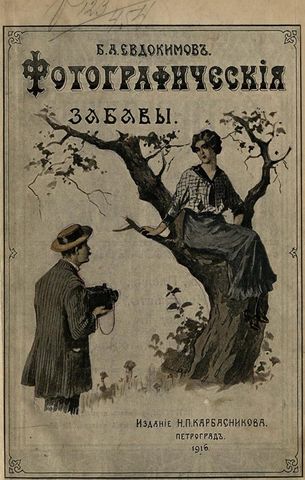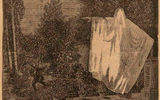SPOILERS

| Added | Thu, 01/08/2019 |
| Release date | 1916
|
| Original title | Фотографическiя забавы
|
| Феномены | |
| References | Б. Евдокимов: Фотографические забавы Изд. В. Секачев, 2018 г.
|
"Photographic fun: Description of experiments and activities that can be easily done with the help of photography" Evdokimov Boris Afanasyevich demonstrates to the modern reader various effects on film photography that our great-grandfathers could and did in the XIX century. From the book, you can learn a lot of interesting photomontage techniques used in the era before the advent of digital image processing methods.
The methods of image manipulation described in the book are available even to amateur photographers and are easily applied at home. They can be used, in particular, for deliberate falsification of "paranormal" images. These methods formed the basis of many later invented photomanipulations with film and photographs, as well as some modern methods of computer retouching.
The book will be especially interesting to researchers of paranormal phenomena studying the phenomenon of ghosts, since several chapters in it are devoted to spiritualistic photography.
The book consists of 35 chapters on 55 pages. Here is a list of these chapters with a brief content:
- Photographic silhouettes. Photographing silhouettes of people against a light source on the background of an improvised screen.
- Photographing aquariums. Photographing fish in ordinary aquariums and in a special device that places the fish in the foreground in a narrow flask that does not allow it to hide in plants or stones.
- Variations of poses with the help of reflection in mirrors. Using two mirrors positioned at an angle to photograph a person from different angles at the same time to choose the best angle or for a prank.
- Prints on the fruit. The use of a natural change in the color of the skin of fruits under the influence of sunlight at a certain moment of ripening to display inscriptions or images on them.
- Photographic prints of flowers, leaves, lace, fabric patterns, etc. A method for creating plant prints directly on photo paper without using a camera is described
- Decoration and decoration of plant prints. Using the plant prints described in the previous chapters to decorate photos
- Photographing spiders and cobwebs. The principle of shooting spiders and webs in two stages (with and without a black background) on one photographic plate.
- Photographic prints as a hygroscope. The use of cobalt chloride in photographs, which can change color depending on humidity.
- Lampshades made of paper. It tells about the methods of making lampshades from paper with inserts for a slide - a positive image on a transparent colorless substrate.
- Photographing flowers. Principles of photographing flower compositions.
- Making vignettes. Principles of making vignettes.
- Composite groups. Principles of making large groups of individual images.
- Photographic dolls. Cutting out a human figure from a photograph to place it in the interior. A similar method was used by Elsie Wright and Frances Griffiths to make "photographs" of fairies
- Bronzed images. Compositions of solutions that are used to produce prints of bronze, aluminum and gold on a uniform black background (ferrotype plate or glass). The principle of fingerprint formation is based on the properties of potassium bicarbonate or ammonium to change the composition of some glucose substances in the light.
- Home production of photosensitive paper and fabric and their use for jewelry. Compositions of solutions for the manufacture of photosensitive paper at home.
- Simplified phototype. A simple principle of making a phototype (obtaining a typographic cliche and replicating halftone images by flat printing) from photographic matte gelatin.
- Hidden photographic image and its application for correspondence. There are several simple ways to put inscriptions or images on paper that will be visible only after certain manipulations. There is also a variant of making ink that will glow in the dark.
- Glowing photos. The use of a special powder for the production of luminous photos.
- Photographing lightning, electric sparks, fireworks and illuminations. A few simple methods of photographing electricity.
- Funny pictures on a black background. The use of a black background and multiple exposures on one photographic plate to achieve unusual effects: imitation of Siamese and ordinary twins, etc., limited only by the flight of imagination of the author of the picture.
- Surprises prospects. Using perspective to create funny photos.
- Spiritual photography. Ways to simulate the appearance of ghosts in the picture (in particular, double exposure and shooting a moving object).
- Photographing clouds and moon effects. Principles of photographing clouds and other atmospheric phenomena.
- Photo-cartoons. Creating photo caricatures by photographing special lithographic drawings or when shooting with a wide-angle lens.
- Photo-bust. The principle of making a portrait in the form of a marble bust using a silhouette mask.
- Crystal background. Creating a frame of crystals on the print using a solution of black-acid magnesium in beer.
- Ways to decorate various objects with photographic images without the help of special paper with a removable layer.
- Photographing without a lens. Methods of photographing without a lens, both conventional and stereoscopic and panoramic images.
- Photographing with simple glasses. The use of ordinary glasses with a flat or convex-concave surface as a lens lens without correcting spherical and chromatic aberrations.
- Photos on Easter eggs. Printing images on Easter eggs prepared and filled with plaster
- Photo miniatures. A method for obtaining several miniature images on the same plate.
- Portraits in the form of postage stamps.
- Transformation of a photographic image into a line drawing. A way to turn any photo into a line drawing using a drawing pen and special ink.
- Photographic sketches. Methods of making an imitation of a pencil, ink, sepia drawing from a photograph.
- Photographic bas-reliefs. Methods of making a convex photograph.
Phenomena in artwork: Ghost
The book describes the many possible manipulations, allowing to capture "ghosts" and other strange creatures depending on the author's imagination.
In particular, in the Chapter "Spiritual photography" shows you how this purpose to use a double exposure, photographing on a single plate the first "Ghost" on a black background, and then the usual landscape or portrait. Another method is to shoot a moving object: for example, cut on the cardboard skull first, holding motionless for a few moments and then move in zigzag motions in the image getting blurred translucent plume.
Translated by «Yandex.Translator»
Log in or register to post comments




